
 |
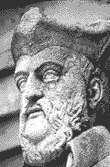 |
|
|---|---|---|
|
Accueil |
Frontispices |
|
 |

 |
 |
|
|---|---|---|
|
Accueil |
Frontispices |
|
 |
ANALYSE |
23
The French original of the Horoscope for Prince Rudolph :
|
|
Un de nos correspondants en Allemagne, Elmar R. Gruber, vient de sortir un ouvrage intitulé : Nostradamus. Sein Leben, sein Werk und die wahre Bedeutung seiner Prophezeiungen [Nostradamus. Sa vie, son travail et la véritable signification de ses prophéties], publié chez Scherz à Berne (Avril 2003). Il analyse pour nous deux documents exceptionnels sur Nostradamus qu’il a retrouvé : l’horoscope du prince Rodolphe de Habsbourg, plus tard l’empereur Rodolphe II.
Nous connaissions déjà le manuscrit allemand évoqué par Pierre Brind’Amour dans la bibliographie à la fin de son Nostradamus astrophile, conservé à la Bibliothèque Kungliga à Stockholm, mais il n’existe encore aucune transcription et traduction de cette importante pièce. Le premier document retrouvé par Gruber est une traduction latine du manuscrit allemand, conservée à la Bibliothèque de Wolfenbüttel en Allemagne. Comme pour le précédent manuscrit, il comporte à la fin une lettre suivie de 28 aphorismes à l’attention de l’empereur Maximilien II, datée du 7 août 1565. Le second document nous semble le plus important, car il s’agit, selon toute vraisemblance, du manuscrit français original - écrit par le secrétaire de Nostradamus -, conservé à la Bibliothèque universitaire d’Augsbourg, et envoyé par l’astrophile salonnais à Hans Lobbet dans cette dernière ville précisément. Il ne comporte pas, cependant, les aphorismes des manuscrits latin et allemand, et il est daté du 20 juillet 1565. On espère une publication prochaine de ces trois manuscrits. Robert Benazra |
Until recently in scientific circles only a German manuscript of the horoscope cast and interpreted by Nostradamus for Prince Rudolph of Habsburg (1552 - 1612), the later emperor Rudolph II was known. Pierre Brind’Amour has given the bibliographical details1, but no transcription and translation has been executed until today. This might be due to the rather artificial calligraphy of the manuscript, which renders reading difficult :
“Des durchleuchtigisten und hochgebornen fursten und herrn Rudolphs Ertzherczogen Zw Osterreich, Herrn Maximilians, Romischen Königs Erstgeborenen Sons und kunfftigen Successores volger dem achtzehenden Julij umb sechs uhr funfundvierzig Minuten nach Mittag Im fünftzehenhundert und zwayundfünftzigsten Jar Zw Wien In Osterreich under des Pole hoch achtundvierzig grad geborn Aigentliche beschreibung seiner Nativität und geburt durch die erfindung, des grads des aufsteigenden Zaichens und seiner gantzen bedeutung mitt allem Vleiß ausgelegt und gerechnet durch Michael Nostradamum im 1564. Jar. [At the end:] Den sibenden Augustij des 1565. Jars vollendet. ”
Kungliga Biblioteke, Stockholm [D. 1343]
During the last years I was able to locate two more manuscripts of this highly interesting work. The first one is a Latin translation preserved at the Herzog August Wilhelm Library in Wolfenbüttel, Germany :
“Nativitas Ser[enissi]mi et Potentissimi Principis, D[omi]ni Rudolphi, Invictissimi Principis, D[omi]ni Maximiliani, Regis Romanorum, filij, nati die 18ua Julij, hora sexta minuta 45 à meridie, anno 1552. In ciuitate Vienna Austrae, quo ion loco altitudo poli est 48. graduum: una cum perfecta inventione gradus horoscopi, et amplis suis significationibus. Per Michäelem Nostredamum fideliter calculata et explicata. Anno 1564. [fol. 127r] Ex Sallon de Crau Provinciae oppido, die 20 Julij 1565.”
Herzog August Wilhelm Library, Wolfenbüttel [Cod. Guelf. 208 Extrav.]
The size of the folios is 20,3 x 15,5 cm, the size of the writing 14,5 - 15,5 x 11 - 12,5 cm. The V plus 134 folios consist of fols. Ir - IIIr (empty), on fol. IIIv the chart of the horoscope, on fol. IVr Aspectus praecedentes partum (aspects of the planets), fol. Vv Latitudinis Planetarum (position of the planets). The text of the interpretation starts with the title as given above Nativitas Ser[enissi]mi et Potentissimi Principis, D[omi]ni Rudolphi […] on fol. 1r. Beginning with this page, the folios are numbered consecutively on recto starting with 1 through 133, with one last blank folio. Fol. 127v carries the letter of Nostradamus to emperor Maximilian II (1527 - 1576), the father of Rudolph. Fols. 128r to 133r contain 28 aphorisms. The aphorisms are signed 7 August 1565 [fol. 133r].
The compiler of the catalogue of the Extravagantes-collection at the Herzog August Wilhelm Library places the manuscript in the second half of the 16th century. The vellum cover with gilded stamps is typical for the time and also contemporary. The manuscript has been written by one hand in an extraordinarily clear calligraphic handwriting. How the manuscript came into the possession of the Wolfenbüttel Library is unknown.
The second manuscript of the horoscope that I could localize is the most interesting of all three, as it is the French original sent by Nostradamus to Hans Lobbet in Augsburg, the negotiator for his customer Daniel Rechlinger (or Rehlinger), as we know from Nostradamus’ correspondence.2 This manuscript obviously remained in Augsburg, as it is today in the Oettingen-Wallerstein-Library, pertaining to the University-Library of Augsburg :
“La nativite avecques la parfaicte invention du degre de lhoroscope et ses amples significations fidelement explicquees, du treshault, tressublime et trespuissant prince Rodolphus, filz du tres victorieuix et tres invincible Maximilianus roy des Rommains dung XVIII de juillet a 6 heures 43 minutes3 apres midi lan 1552 Viennae austriae altit. poli 48. Per Michaelem Nostradamum calculata et explicata. M.D.LXIIII. [At the end, fol. 107r:] De Sallon de craulx en Provence ce XXe juillet 1565. ”
Oettingen-Wallerstein-Library of the University-Library of Augsburg [Cod. I 4 4(o) 1]
The manuscript consists of 107 folios and is written in French 16th century italics. Interspersed in the French text are numerous Latin sections. It reveals the typical style of Nostradamus with its characteristic phrases, comparisons, metaphors and turns of expression.
The size of the folios is 21,5 x 15,5 cm, the size of the writing 20 x 12,5 cm. The folios were originally larger, but have been trimmed considerably at the end of the 18th century, when the manuscript was rebound. Fol. 1r bears a title by another hand : Michael de Nostredam : La Nativite du prince Rodolphe, fils aine de I'Empereur Maximilian II. 1565. On fol. 2r we find the birth chart including the table of aspects and positions of the planets. The text starts on fol. 3r with the above cited title and chapter I. It is divided in 46 chapters but lacks the 28 aphorisms which are conserved in the ms Wolfenbüttel and the ms Stockholm. It ends on fol. 107v with the letter to Maximilian II.4
“Ad Caesarem Imp.
Javois tresinclit. Sire en deliberation de inserer cent ou deux centz aphorismes pour plus ample approbation de ce qui est dessus escrit tant extraictes des Arabes grecz Latins que autres, mais pour cause du trop grand repentin department du tabellarius ou messaiger, il ne ma este possible de les parachever esperant les faire veoir plus amplement au sceptre de votre Imperialle Mageste. Par la nativite du tresillustre prince Ernestus, Dieu soit en votre perpetuelle preservation en ce monde De Sallon ce VII.e daoust 1565.
Faciebat Michael Nostradamus a consiliis medicae et mathematicarum francoys regis, die septima Augusti 1565.
Votrae clementiae deditiss. Michael de Nostredam.”
The letter is signed 7 August 1565, the same day as he wrote the letter accompanying the horoscope to Hans Lobbet, in which we read the interesting passage :
“Que si Dieu fait la grace, que ce mien petit labeur puisse parvenir entre les mains de Cesar le pere, je suis asseuré, qu'il n'en prendra moins de delectation, que sa Majesté sera prise d'admiration. Et pour ce je vous envoye le tout, tant l'escrit de ma main, car il fault que j'escrive le tout, & puis la transcription.”5
Unfortunately the manuscript in question is not the one “escrit de ma main”, but the transcription announced to Lobbet by Nostradamus. The original handwriting of Nostradamus, at that time late in his life must have been almost unreadable, as many of his correspondents complained. Maybe the recipients did not even keep it and hence only the transcription survived. But nonetheless it is beyond any doubt that this is the original transcription in a fluent and clear handwriting. It still makes a difficult reading, due to the irregular use of punctuation-signs, and the almost complete absence of accents. Moreover the sentences are sometimes composed in a rather awkward manner, rendering it at times challenging to penetrate their meaning. This problem becomes obvious by studying the Latin and German translations. In some instances the translator had no clear understanding of the meaning of a word or phrase - which is no surprise, given Nostradamus’ unusual use of words and syntax in addition to the erratic use of punctuation in the French source. In this case the translator of the Latin version in the ms Wolfenbüttel left a blank space and noted in the margin the corresponding French term from the ms Augsburg. He likewise made an effort to grammatically correct the Latin passages, which are full of mistakes and maladroit wording in the French original, while the German translation copies the Latin insertions with only few alterations. In general the German rendering in the ms Stockholm shows much more freedom in the translation than in the Latin version.
It seems that the French manuscript remained in Augsburg while only copies were forwarded to the emperor. The fact that the German manuscript ended up in Sweden, gives a clue that this document at least reached the emperor and was presumably kept by his son Rudolph II when he moved the court to Prague. Most probably it became then part of the booty made by the Swedish troops around 1630 in Prague.
Possibly the Augsburg aristocrat and merchant Markus Fugger (1529 - 1597), who since 1550 had established a significant erudite library, was engaged in the negotiations about the horoscope with the court of Maximilian II in Vienna. In the year 1653, when his grandson Marquard Fugger (1595 - 1655) sold the Library of his grandfather to the counts of Oettingen, a catalogue was prepared, in which we find the first notice about the existence of the French manuscript. The entry in the catalogue reads : La nativité avec la parfaicte invention du degrez de l´horoscope par Michel Nostradam. This library, together with the collection of the counts of Oettingen later entered the Oettingen-Wallerstein-Library of Augsburg.
Of course the contents of the horoscope are of enormous interest for nostradamian research. It is the only complete original interpretation of a horoscope by Michel de Nostredame extant, and it is furthermore a very extensive one. Of great importance is the changed political stance from the earlier works of Nostradamus in regard to the question of a future world emperor - an inquest so dear to the prophetic tradition going back to the time of Joachim of Fiore.
Furthermore we now have the possibility to study in detail Nostradamus’ application of astrological theory. Indeed his expositions are a mixture of conventional astrological interpretation and “prophetic inspirations”. There are even several passages about general future political developments and events interspersed in the text, which cannot be due to the interpretation of the planetary positions in the birth-chart. On the other hand, the horoscope was dressed for a future emperor, whose biography is very well know. In contrast to his prophetic works in the almanacs, prognostics and the centuries, where we do not know which possible future events Nostradamus might have supposedly envisioned, and which therefore can be and are associated to an infinite number of events, we now are offered for the first time the opportunity to assess the pretended prophetic or precognitive abilities of Nostradamus by comparing his assertions in the text of the horoscope with the actual circumstances of emperor Rudolph’s life. It is precisely this task that I have undertaken in my new book Nostradamus. Sein Leben, sein Werk und die wahre Bedeutung seiner Prophezeiungen (Nostradamus. His Life, his work, and the true meaning of his prophecies) just published in German.6 In it I present a comprehensive examination of the prophetic work of Nostradamus, relying on the so far largest pool of original sources, including Chavigny’s Recueil des présages prosaiques [Ms Lyon 6852], which I was transcribing at the same time as Bernard Chevignard was engaged in this work7, and of course including a detailed analysis of the horoscope for prince Rudolph.
The horoscope contains many interesting peculiarities which cannot be described in this short bibliographical note. Let me cite but one instance which demonstrates the degree of self-confidence that Nostradamus has reached towards the end of his lifetime with his sumptuous interpretations of horoscopes for rich merchants, aristocrats, and kings. He introduces his discussion of the kind and time of death that prince Rudolph will face with a scholarly prelude in which he invokes the story and the fate of Domitian’s astrologer Askletarion with the words : “[…] sed nec mathematicus nul que soit au monde, de morte imperatoris ne a jamais sceu prononcer, ormis Ascletarion, que de la Germanie a Domitianus presaigera lan jour et heure […]” [fol. 22v]
With these words he seems to want to avoid the precarious task of predicting the hour of death to such an important person as a future emperor, since the bold Askletarion was so imprudent to have forecast how and when Domitian would die.8 The emperor wanted to take revenge on such a audacious statement and asked him, how he, Askletarion himself would die. The astrologer answered he would be torn apart by dogs. Domitian, who was determined to disprove his prediction, gave order that Askletarion be burnt on the stake. A storm broke out, put out the fire, and a pack of wild dogs tore the body of Askletarion apart.
After evoking this classical tragedy of Askletarion, Nostradamus does not proceed to avoid forecasting the fate of Rudolph, he even goes into details about the death of his father Maximilian II, which he expects in the year 1589. For Rudolph he predicts that he will live for 72 years [fol. 54v] and repeats towards the end of the horoscope : “ […] sy Dieu le permet et nature ne vous face tort que votre vie est de 4 foys dix huit ans.” [fol. 91r]
Nostradamus obviously took great care in an effort to equal Askletarion’s accomplishment when he writes that he dedicated more time than for any other aspect of the horoscope to calculate the term of death for Rudolph’s father : “[…] la ou il ya mors patris cum deffinitione temporis qui a este la cause plus principalle que jay demeure long temps a la calculation de cest article plus que a nul des autres […]” [fol. 23v]. In a prophetic inspiration, Nostradamus subsequently describes the moaning of the people and even does not abstain from composing himself an epitaph for Maximilian. From the viewpoint that Maximilian is exactly the person to whom the horoscope for his young son is addressed to, means a rather courageous stance for Nostradamus to incorporate in his text elaborate passages on the fate of the present emperor, including the time and circumstances of his own death. Nostradamus, confident about his prophetic faculties, has no problems to surpass the licit boundaries of astrology with individual and bold predictions like these :
“Ce roy y assister et faire de grandes prouesses et au pere diverses inscriptions comme plainctes deplorations toute la chrestiente en melancolie et seront mises telles ou sembables inscriptions, peu de temps apres, sy quelcun veult obstater que cest oultrepasser les termes de lastrologie, le temps quant les affaires se presenteront fera foy du tout.” [fol. 23v]
The time has indeed testified the events outlined, but not in favor of Nostradamus :
Rudolph II did not live for 72 years, but died when he was 60 years old in 1612, and in the year 1589 - the term predicted by the prophet of Salon - Maximilian II was already dead for 13 years, as he died on 12 October 1576.
Elmar R. Gruber
Pictures

Ms Stockholm
The drawing of the birth chart for Rudolph and the title page of the horoscope
in the German translation of Ms Stockholm.
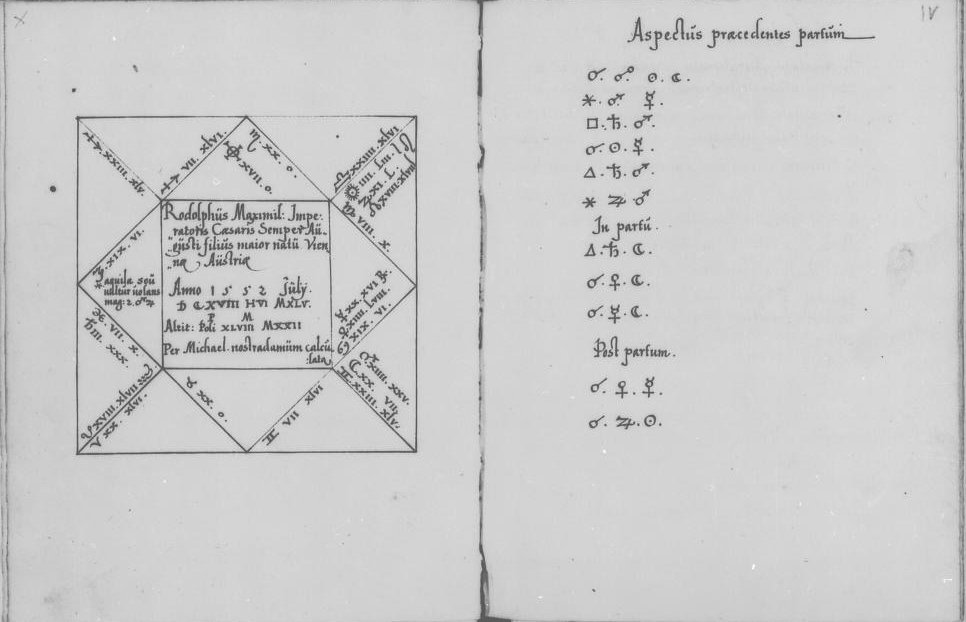
Ms Wolfenbüttel IIIv and Ivr
Fols. IIIv and IVr of the Latin ms Wolfenbüttel
carry the chart of the horoscope and the aspects of the planets.
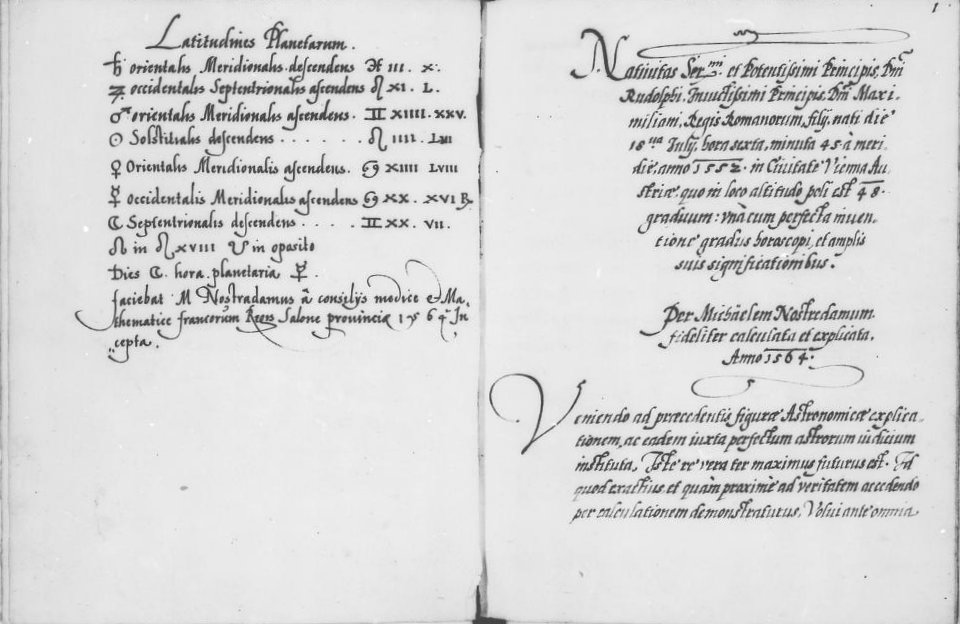
Ms Wolfenbüttel Vv 1r
On fol. Vv in the Latin translation of the ms Wolfenbüttel we find the entries of the position of the planets.
On fol 1r the text of the horoscope with the perfectly clear calligraphic handwriting begins.
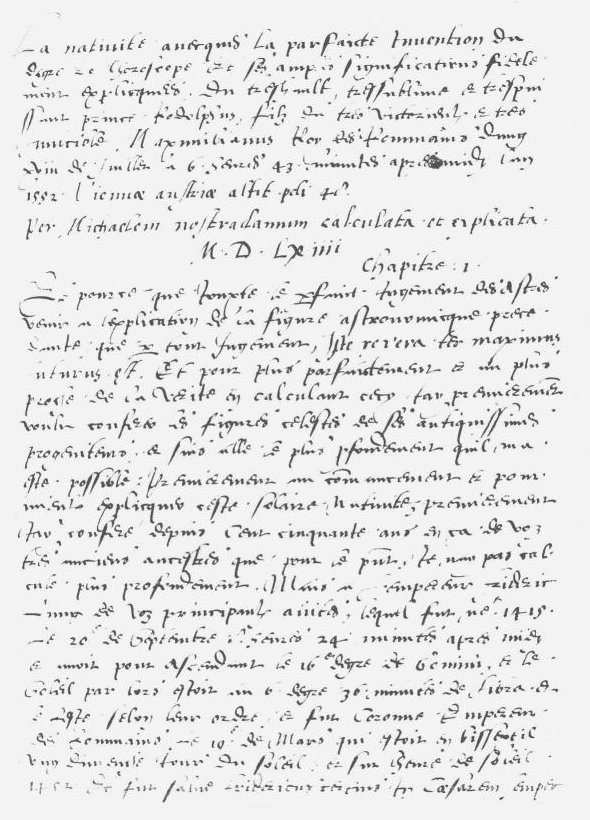
Ms Augsburg 3r
The beginning of the text of ms Augsburg on fol. 3r. After the introductory title the text start on chapter I :
“Et pource que jouxte le parfaict jugement des astres venir a lexplication de la figure astronomicque precedante,
que partout jugement, iste re vera ter maximus futurus est. Et pour plus parfaictement et au plus proche de la verite
en calculant cecy jay premierement voulu conferer les figures celestes de ses antiquissimes progeniteurs,
et suis alle le plus profondement quil ma este possible.”
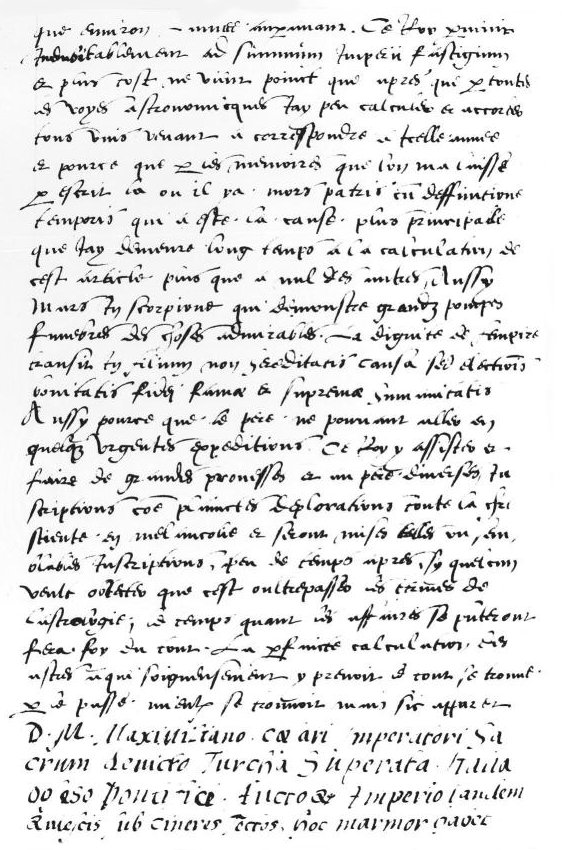
Ms Augsburg 23v
On fol 23v we encounter some of the discussion of Nostradamus about the death of both
the owner of the horoscope in question, prince Rudolph, and his father, emperor Maximilian II.
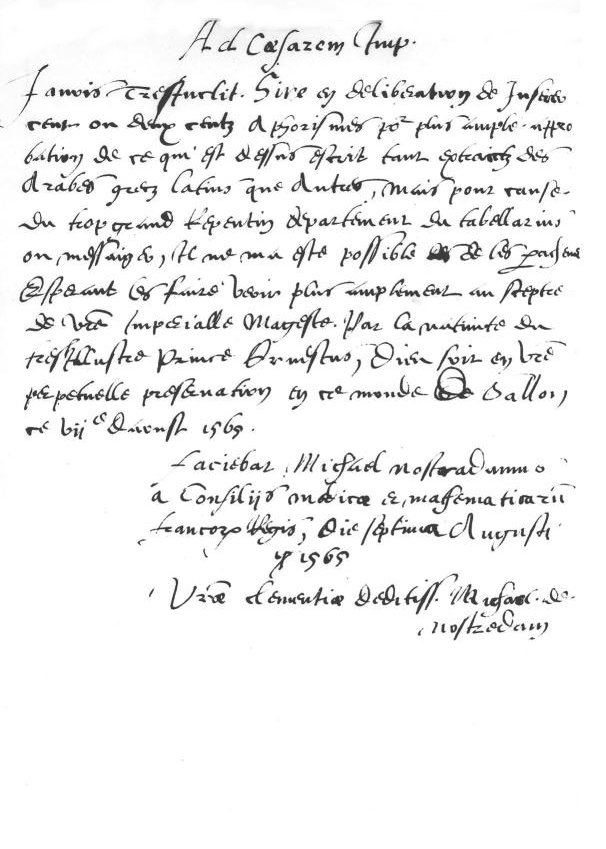
Ms Augsburg 107v
The end of the ms Augsburg is marked by the letter of Nostradamus to his addressee,
the emperor Maximilian II, the father of Rudolph.
Notes
1 Cf. Pierre Brind’Amour, Nostradamus astrophile. Les astres et l’astrologie dans la vie et l’œuvre de Nostradamus, Paris, Klincksieck, 1993, p. 482 - 484. Retour
2 Cf. Jean Dupèbe, Nostradamus, lettres inédites, Genève, Droz, 1983, Appendix 1, pp. 166 - 167. Retour
3 In the central cartouche of the horoscope drawing [fol. 2r] the time is given as “H. VI. M. XLV” (6 hours, 45 minutes). Retour
4 In my citations from the ms Augsburg I leave the original lettering and do not include accents when absent. Retour
5 Cf. Dupèbe, Appendix 1, pp. 166 - 167. Retour
6 Cf. Elmar R. Gruber, Nostradamus. Sein Leben, sein Werk und die wahre Bedeutung seiner Prophezeiungen, Bern, Scherz, 2003, pp. 314 - 348. Retour
7 In contrast to Bernard Chevignard (Présages de Nostradamus. Présages en vers 1555 - 1567, présages en prose (1550 - 1559). Paris, Seuil, 1999) who published only the présages en prose till the year 1559 I transcribed for my own project most of the extracts - as far as it was possible, given the poor condition of the manuscript. Retour
8 Cf. Pieter J. Sijpesteijn, The astrologer Askletarion. Mnemosyne, 43, 1990, 164 - 165. Retour
Retour Analyse
Tous droits réservés © 2003 Elmar R. Gruber